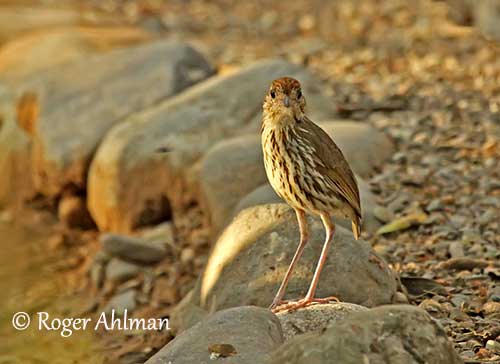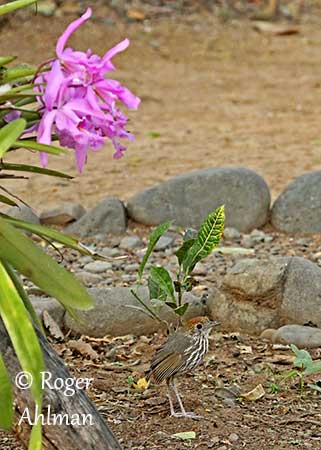
Fr: Grallaire de Watkins
Ang: Watkins’s Antpitta – Scrub Antpitta
All: Buschlandameisenpitta
Esp: Tororoí Matorralero
Ita: Pitta formichiera di Watkins
Nd: Watkins' Mierpitta
Sd: tumbesmyrpitta
Photographer:
Roger Ahlman
Pbase Galleries Peru and Ecuador & My bird pictures on IBC
Text by Nicole Bouglouan
Sources:
HANDBOOK OF THE BIRDS OF THE WORLD Vol 8 By Josep del Hoyo-Andrew Elliott-David Christie - Lynx Edicions - ISBN: 8487334504
BIRDS OF SOUTH AMERICA – Passerines - by Robert S. Ridgely and Guy Tudor – HELM Field Guides – ISBN: 9781408113424
BIRDS OF PERU by Thomas S. Schulenberg, Douglas F. Stotz, Daniel F. Lane, John P. O’Neill, Theodore A. Parker III – Princeton University Press 2007-ISBN: 978-0-691-13023-1
CREAGUS@Monterey Bay (Don Roberson)
Neotropical Birds – Cornell Lab of Ornithology
Description of the nest, egg and nestling of Watkins’s Antpitta - Grallaria watkinsi
Antpittas and worm-feeders: a match made by evolution?
Watkins’s Antpitta or Scrub Antpitta
Grallaria watkinsi
Passeriformes Order – Grallariidae Family
INTRODUCTION:
The antpitta genus Grallaria is the largest of the family with more than 30 species ranging from medium-sized birds at high elevations, to very large antpittas found in the lowlands. They may show attractive combinations of rufous, black and grey, but they often have dull-coloured plumage overall.
The Watkins’s Antpitta is mostly located in Ecuador, in deciduous and montane forest, woodland and borders. The long legs and large feet are adapted to its terrestrial life.
This species is threatened by habitat loss through clearance of forest and scrub for agriculture expansion, but it is present in several protected areas. It is currently listed as Near Threatened, but it is still fairly common in its restricted range.
The name of the species pays tribute to Henry George Watkins, an English collector in Peru.

DESCRIPTION OF THE BIRD:
Biometrics:
Length: 18 cm
Weight: 60-84 g
The Watkins’s Antpitta adult has pale olivaceous upperparts with narrow whitish streaks on the back. On the wings, the flight feathers are pale olive-brown or pale tawny brown, whereas the wing-coverts are pale olive. The short tail is pale olive too.
On the underparts, chin and throat are white with narrow, dark, lateral stripes. Rest of underparts is white with dark olive streaks, mainly on breast sides and body sides. Central belly, vent and undertail-coverts are white.
On the head, crown and nape are pale rufous with narrow, whitish streaks. Lores and eyering are buffy-white to pale buff. The ear-coverts are buff with olive streaks.
The strong, two-tone bill has blackish upper mandible and pale pinkish-grey lower mandible. The eyes are dark brown. The long legs and feet are pale pinkish to pale horn.
Male and female are similar. The juvenile is not described.
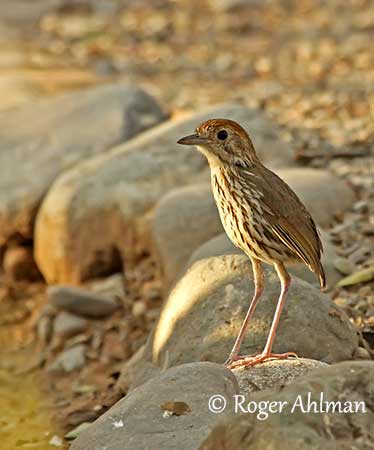
RANGE:
The Watkins’s Antpitta is found in the coastal mountains of W and SW Ecuador (SW Manabí and W Guayas, and El Oro and Loja). It is also present in adjacent NW Peru (Tumbes and possibly Piura).
HABITAT:
The Watkins’s Antpitta frequents dry, semi-deciduous and locally evergreen forests and second growth, including disturbed areas.
The species is visible from sea-level up to 1800 metres of elevation, but it is usually found above 400 metres.
In Peru, it is recorded between 400 and 900 metres. It is restricted to the greener parts of the forest, and mainly in the dense vegetation of narrow ravines.
CALLS AND SONGS: SONS PAR XENO-CANTO
The song of the Watkins’s Antpitta is a series of 4 to 7 distinct and emphatic whistled notes with longer and sharply upslurred last note “CLEW clew clew clew clew cu-HOOEE ?” followed by rising sharp whistle. This song is usually given from the ground or a low branch, at dawn and dusk during the breeding season.
The call is like the last note or the three last notes of the song, but faster “clew-clewEE ?”
Outside breeding season, the bird calls in late morning.
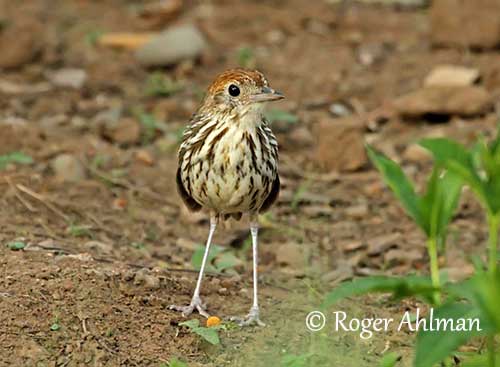
BEHAVIOUR IN THE WILD:
The Watkins’s Antpitta forages on the floor of forest edges and in sparse scrub. It feeds on various insects including grasshoppers. It also takes earthworms and other terrestrial invertebrates. It may consume fruit sometimes.
It is often concealed in dense vegetation and hard to see. It forages near or on the ground in dense understorey, but it can be seen searching for food in semi open areas or close to large animals where it can find disturbed invertebrates.
The breeding habits of the Watkins’s Antpitta and other members of family Grallariidae are very poorly known. The bird sings during the breeding season, usually at dawn and dusk, from the ground or a low branch.
Generally, the antpittas bob the head and flick their wings. They also preen frequently.
Territorial disputes may occur with calls and direct fighting. The mates rarely forage together, but they probably remain in vocal contact. This species is presumably socially monogamous, and the pair bonds are emphasized by songs.
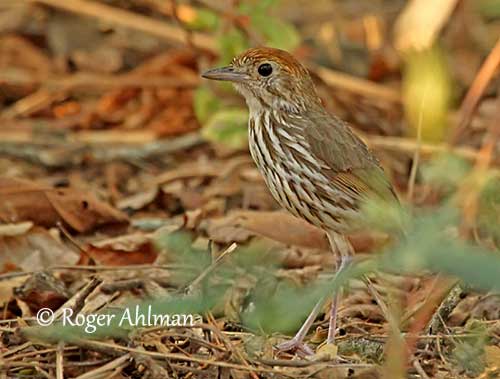
The Watkins’s Antpitta is probably sedentary. It is a poor flier, due to the broadly rounded wings. Most members of this family are nearly flightless. On the ground, their stance is very upright, with the legs placed well on the rear of the body. The bird may sometimes appear quite out of proportion.
REPRODUCTION OF THIS SPECIES:
From an observation in Loja province, Ecuador, a nest was located in a patch of trees along a road. It was built in the interior branches of a thorny tree, at 3/3,5 metres above the ground, and 0,5/1 metre below the canopy. The bulky cup was made with sticks and vine twigs, and a few dead leaves. Some black rootlets were used as lining.
There were one egg and one chick in the nest, with an adult brooding the chick while incubating the turquoise to pale greenish-blue egg. The chick was almost naked with dark pinkish skin and sparse blackish down. Bill, gape and mouth were bright orange, except a black nail at tip of upper mandible.
The hatching appears to coincide with the middle of the rainy season (March) and more generally between January and April in this region. No more information.
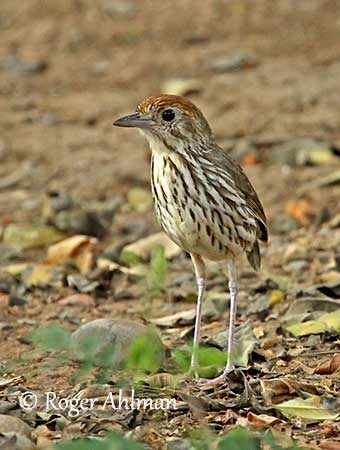
PROTECTION / THREATS / STATUS:
The Watkins’s Antpitta has small range in which it is threatened by forest and scrub clearance for agriculture expansion. The understorey is often destroyed by cattle and goats.
But the Watkins’s Antpitta is present in several protected areas in Ecuador and NW Peru. The species is described as “fairly common” but due to its secretive habits, it is hard to see.
The Watkins’s Antpitta is currently listed as Near Threatened.
